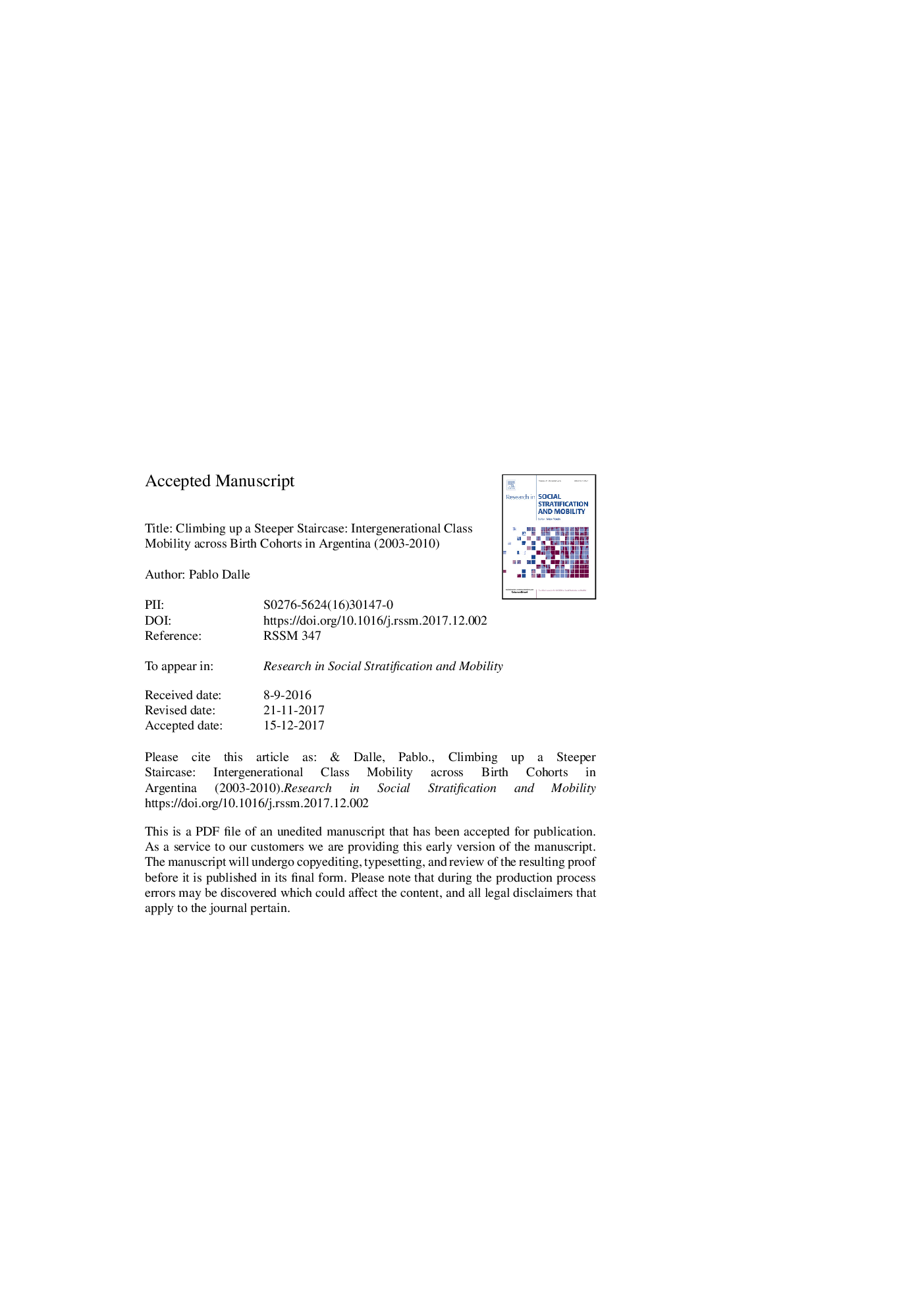| کد مقاله | کد نشریه | سال انتشار | مقاله انگلیسی | نسخه تمام متن |
|---|---|---|---|---|
| 7409889 | 1481558 | 2018 | 55 صفحه PDF | دانلود رایگان |
عنوان انگلیسی مقاله ISI
Climbing up a steeper staircase: Intergenerational class mobility across birth cohorts in Argentina (2003-2010)
ترجمه فارسی عنوان
راهپیمایی صعودی: صعود طبقات بین نسلی در همسایگی های تولد در آرژانتین (2003-2010)
دانلود مقاله + سفارش ترجمه
دانلود مقاله ISI انگلیسی
رایگان برای ایرانیان
کلمات کلیدی
تحرک کلاس بین نسلی، طبقه کارگر، فرصت های ساختمانی، بسته شدن ساختار کلاس، آرژانتین،
ترجمه چکیده
نتایج اول نشان دهنده ارتباط میزان گسترش خالی در کلاس خدمات در تحریک فرآیندهای تحرک طبقه است. در مقایسه با دیگر کشورهای آمریکای لاتین، ایتالیا و اسپانیا، میزان تحرک عمودی بالاتری نسبت به مردان پایین تر است. این نرخ ها برای زنان بالاتر است، در سطوح مشابه با افرادی که در کشورهای صنعتی عقب مانده اند که پیشرفت قابل توجهی در اقتصاد داشته اند، بالاتر است. این نتایج با افزایش نرخ ارتقاء ساختار طبقاتی زنان نسبت به مردان ارتباط دارد. ثانیا، نتایج نشان می دهد که تحرک رو به بالا به طبقه خدماتی و همچنین استخدام طبقه خدماتی از طبقه کارگر در طول زمان برای زنان و مردان در شرایط توسعه اقتصادی ضعیف و ناپایدار کاهش یافته است. سوم، نتایج حاصل از سیالیت اجتماعی در طول همجواری تولد نشان می دهد که در زیر یک روند کلی سیالیت ثابت، تغییرات پیش فرض در الگوی تحرک کلاس وجود دارد که شامل افزایش سیالیت بین طبقات در نیمه پایین ساختار کلاس و کمتر جابجایی بین حمل و نقل بین کلاس های کار و کلاس خدمات. فرزندان خانواده های طبقه کارگر صعود کرده اند به یک راه پله ای پیوسته، زیرا موانع کلاس در طبقات متوسط بالا، به ویژه در میان مردان افزایش یافته است. این یافته ها به حمایت از مطالعات قبلی کمک می کند که بر نقش تعیین کننده ارتقاء ساختاری ساختار طبقاتی در تحرک طبقات بالادست و تأثیر خوردگی شرایط رفاه طبقه کارگر بر سیالیت اجتماعی منفی تأکید دارد.
موضوعات مرتبط
علوم انسانی و اجتماعی
اقتصاد، اقتصادسنجی و امور مالی
اقتصاد، اقتصادسنجی و مالیه (عمومی)
چکیده انگلیسی
The results firstly show the relevance of the expansion of vacancies in the service class in impelling of upward class mobility processes. The rates of vertical upward mobility have been lower for men when compared with other Latin American countries, Italy and Spain. These rates are higher for women, situated in similar levels to those in late industrialized countries which have experienced substantial economic advances. These results are related to higher rates of class structure upgrading for women than men. Secondly, results demonstrate that long distance upward mobility to the service class as well as recruitment of the service class from working class have decreased over time for both men and women in a context of low and unsteady economic development. Thirdly, the results about social fluidity across birth cohort suggest that underneath a general trend of constant fluidity, there have been suggestive changes on the pattern of class mobility that consist of an increment of fluidity between classes at the bottom half of the class structure and less long-distance mobility between working classes and the service class. The offspring's of working class families have been climbing a steeper stairway because class barriers in the upper middle classes have increased, especially among men. These findings contribute to support previous studies which emphasize the decisive role of structural upgrading of class structure in vertical upward class mobility and the effect of the corrosion of working class welfare conditions on negative social fluidity.
ناشر
Database: Elsevier - ScienceDirect (ساینس دایرکت)
Journal: Research in Social Stratification and Mobility - Volume 54, April 2018, Pages 21-35
Journal: Research in Social Stratification and Mobility - Volume 54, April 2018, Pages 21-35
نویسندگان
Pablo Dalle,
